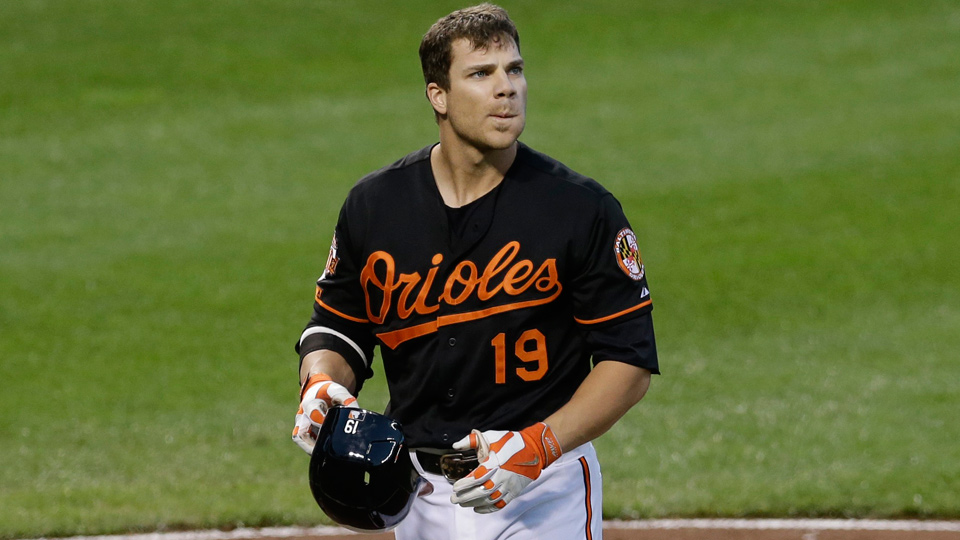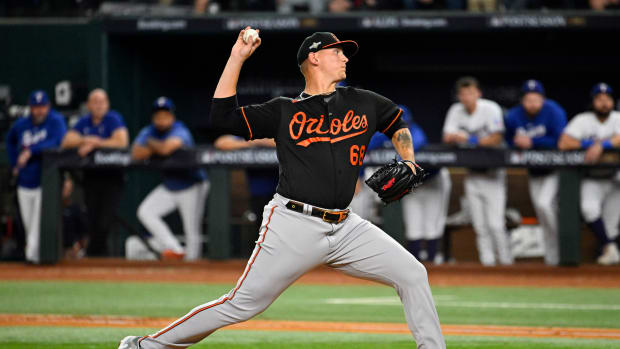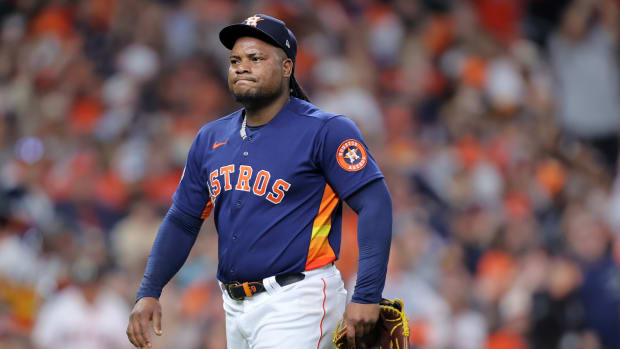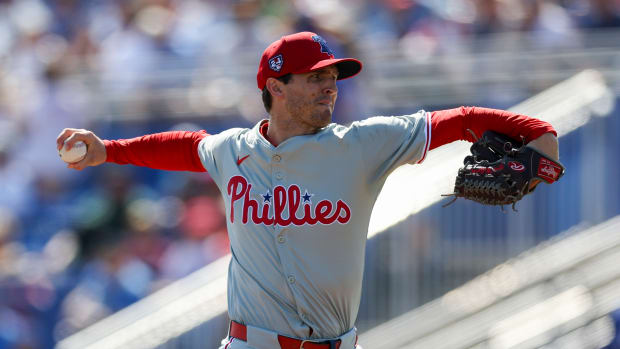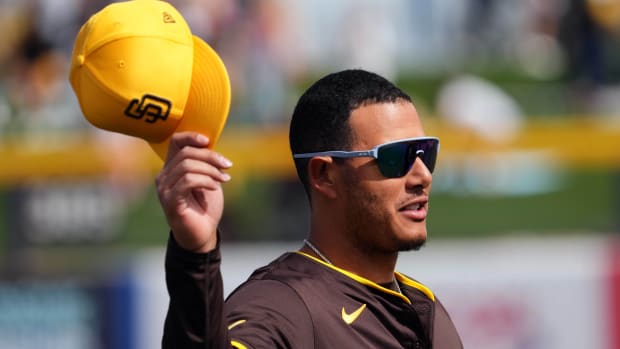What are the biggest weaknesses for MLB's division-leading teams?
Entering Tuesday's action, five of Major League Baseball's six division leaders had an 84.8 percent or better chance of winning their division, according to the postseason odds from former Baseball Prospectus statistician Clay Davenport that we use in our daily standings update. That doesn't mean that those teams have nothing to worry about, however. They may have their divisions on lock, but every team has a weakness. Here, in order of their postseason odds, are the biggest worries for the five division leaders who appear to have their division sewn up.
Washington Nationals
99.5 percent: 81-61, .570, 8 games up in NL East
Weakness: High-leverage relief
From busts to best: The failed starters who became shutdown relievers
In 21 appearances since the All-Star break, Nationals closer Rafael Soriano has blown five of his 14 save chances (for a dismal save percentage of 64) and posted a 6.98 ERA, not counting the fact that he also allowed the only two runners he inherited to score. After he blew saves in his last two appearances last week, the Nationals removed him from the role, at least temporarily. Although manager Matt Williams said he was going to go with a closer-by-committee approach while Soriano worked through his issues in lower-leverage situations, Drew Storen has drawn both of Washington's save situations since. Storen has been excellent this season, posting a 1.31 ERA, 0.98 WHIP, and 3.73 strikeout-to-walk ratio, and saved 43 games for the Nationals in 2011, so the team needn't fret about having a viable closer.
Soriano's issue seems to be little more than a lack of crispness on his pitches — something rest, lower-stress outings, and bullpen sessions, like the one he threw on Monday, may help — and has been arguably exacerbated by poor team defense and some bad luck. However, if Soriano is unable to return to form soon, the Nationals could enter the postseason without a significant late-inning weapon. Even if Soriano doesn't reclaim his closer job, the team needs to have him available and effective as Storen's replacement in the team's set-up chain.
Baltimore Orioles
99.4 percent: 84-59, .587, 10 games up in AL East
Weakness: Infield issues
The Orioles lack a dominant No. 1 starter, with Chris Tillman the pitcher most likely to draw their Game 1 start in the Division Series. However, they have larger problems in their infield, where Manny Machado's season-ending knee injury and the team's failure to find a viable second baseman coming into the season or at the trading deadline have left the Baltimore with uncomfortable compromises at both positions. J.J. Hardy's current back problems (he's headed for an MRI on Tuesday after having sat out the last three games) add further uncertainty.
After a long journey, Steve Pearce finally catching on with the Orioles
Machado's injury exposed a lack of depth that led the team to conclude that its best option at the hot corner is first baseman Chris Davis. Davis played third base exclusively in 2007, a season he split between High-A and Double-A, and split his time between the two infield corners all the way up until 2011, but he hadn't played third at all in 2012 and 2013 and is clearly a subpar fielder at the position. What's more, the average major league third baseman has hit .259/.318/.401 this season; Davis has hit .195/.301/.408, including a .183/.258/.433 line in 66 plate appearances as a third baseman. That's the replacement the team has come up with for Machado, one of the game's best fielders, who had hit .311/.353/.505 from the end of May through his injury on Aug. 11.
The Orioles are at least getting superlative defense out of second baseman Jonathan Schoop, who is also third in the majors in home runs by a second baseman with 15 (behind Brian Dozier's 20 and Neil Walker's 19). However, Schoop's on-base percentage is a killer; at .249, it is dead last among hitters with 400 or more plate appearances this season. In fact, since play resumed after the 1994 player's strike, only six hitters have made 400 or more plate appearances in a season with a lower OBP, and, unsurprisingly, none of them played on a team that made the postseason.
Revisiting this season's trade deadline deals: Who won, who lost?
Los Angeles Angels
98.1 percent: 88-55, .615, 8 games up in AL West
Weakness: Starting rotation
Similar to the situation in the Orioles' infield, the Angels' lack of depth in their rotation has been exposed by not one, but two season-ending injuries. First, Tyler Skaggs suffered a torn ulnar collateral ligament in his July 31 start (he had Tommy John surgery on Aug. 13). Then, Garrett Richardsruptured the patellar tendon in his left knee covering first base on Aug. 20. Either injury on its own might have been something the team could have absorbed. But the two in combination have sapped the team's rotation depth to such a degree that, even with expanded rosters, Cory Rasmus, who hadn't started a game at any level since 2011, has been forced into Richards' vacated spot in the rotation.
Dominant most of season, Oakland Athletics limping to finish line
Thus far, in two starts, Rasmus has pitched just 3 2/3 innings and threw more pitches in his last relief outing (51) than he has in either of his two starts. Still, he'll get another turn on Thursday against the Rangers. With Rasmus in the rotation, the Angels are effectively throwing a bullpen game once every five games, something they can endure only because of the size of their lead and the fact that rosters are, as noted, expanded in September.
The good news for the Angels is that they won't need a fifth starter in the postseason, but despite being able to jettison Rasmus from the rotation come October, the loss of Richards is likely to become even more glaring then. He had been far and away the team's best pitcher this season, leading the rotation in ERA (2.61), ERA+ (139), WHIP (1.04), and strikeout-per-nine ratio (8.8). In his absence, the team's best starter just might be 27-year-old rookie Matt Shoemaker, a soft-tossing righty who didn't really become a fixed part of the rotation until Skaggs' injury. Shoemaker, whose success is based on his excellent control and a devastating splitter, is a nice story — 27-year-old rookie non-prospect emerges as staff ace for best team in baseball — but he's not the pitcher you want as your top starter heading into the postseason.
St. Louis Cardinals
91.9 percent: 80-64, .556, 4 1/2 games up in NL Central
Weakness: Rightfield
The Cardinals' deadline additions of Justin Masterson and John Lackey have thus far been total busts, as the two have combined to post a 5.94 ERA in 13 starts and one relief appearance. However, with the division in hand, Michael Wacha back off the disabled list, and Shelby Miller having pitched well of late, the Cardinals could shrug off those performances with a postseason rotation of Adam Wainwright, Wacha, Miller, and Lance Lynn. They could also get valuable relief work from side-arming righty Masterson, who has already been bounced to the bullpen.
MLB Power Rankings: Cardinals are scorching in September
What they seem perpetually unable to fix, however, is their hole in rightfield, where the Cardinals' 67 sOPS+ (adjusted OPS measured against league-average for that split) has been the worst in baseball. There's no remorse over trading Allen Craig, who was the bulk of the problem for the season's first four months, as he has been even worse in Boston than he was in St. Louis this season. But rookie Oscar Taveras has yet to reward the team for clearing the position for him, hitting just .244/.292/.289 in August. While he did shown some signs of life at the plate over the weekend — hitting his first home run since July (and just the third of his big-league career) on Saturday, then going 3-for-4 on Sunday — Taveras has yet to put together any kind of sustained hitting performance.
The Cardinals have some options, both of which they have tried in small measures. They can platoon righty Randal Grichuk with the lefty Taveras or push the red-hot Jon Jay to right and play Peter Bourjos in center. The ideal solution, however, would be to have Taveras, one of the game's top hitting prospects, catch fire and carry that performance over into the postseason.
Mets GM Alderson says team won't spend big in offseason
Los Angeles Dodgers
84.8 percent: 82-62, .569, 3 1/2 games up in NL West
Weakness: Catchers
Fighting for NL West title, Dodgers need Puig to snap long slump
The average major league catcher has hit .247/.312/.383 this season. The Dodgers' catchers, primarily A.J. Ellis and Drew Butera, have hit .182/.283/.259. That translates to a 58 sOPS+; only the Rays' catchers have been worse (54 sOPS+) at the plate. But Tampa Bay's catchers (primarily Jose Molina and Ryan Hanigan) rank among the best pitch-framers in the majors (third-best per Baseball Prospectus' Fielding Runs Added By Count, which credits catchers for the run value of extra strikes gained depending on the count on the batter when they occur). The Dodgers' backstops, on the other hand, are collectively in the bottom half of the league in framing, 21st overall per Fielding Runs Added By Count.
Ellis' slugging percentage of .237 is the worst by any batter with 250 or more plate appearances this season, he's among the worst pitch-framers in the game, and he has thrown out just 20 percent of attempting base stealers (compared to a league average of 27 percent). Ellis may be well liked in the clubhouse and get on base at a respectable clip (.328 OBP with as many walks as strikeouts this season), but he has done more harm than good on the field this season. As far as whether or not Ellis calls a good game, the only thing we can say for sure is that he struck gold when he told Josh Beckett to throw his curveball more often back in May. But with Beckett out for the season with a hip injury, Ellis doesn't even have that to point to any more.






























